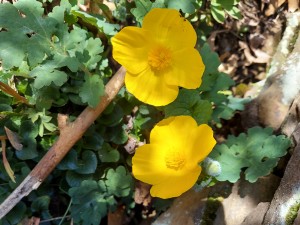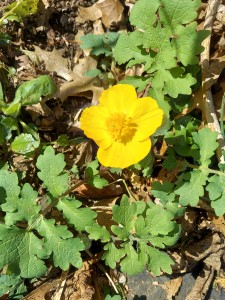 After all the grayness of winter, it is an absolute revelation to see yellow-flowered plants springing up in the garden. Usually the yellow blooms in my part of the world appear in sequence. The little yellow miniature daffodils come first, eventually to be succeeded by their later flowering narcissus relatives. Once the mini daffs are gone, stream banks and wet places are filled with low-growing, buttercup-yellow marsh marigolds, with shimmering petals that open wide to greet the sun and close up when it is cloudy or dark. Just about the time that the marsh marigolds drop their petals and assume anonymity until next spring, the celandine or wood poppies come roaring out of fat buds, flaunting their golden yellow crepe papery petals.
After all the grayness of winter, it is an absolute revelation to see yellow-flowered plants springing up in the garden. Usually the yellow blooms in my part of the world appear in sequence. The little yellow miniature daffodils come first, eventually to be succeeded by their later flowering narcissus relatives. Once the mini daffs are gone, stream banks and wet places are filled with low-growing, buttercup-yellow marsh marigolds, with shimmering petals that open wide to greet the sun and close up when it is cloudy or dark. Just about the time that the marsh marigolds drop their petals and assume anonymity until next spring, the celandine or wood poppies come roaring out of fat buds, flaunting their golden yellow crepe papery petals.
This year, for better or worse, all those yellow flowers have popped up at once. That might be due to climate change, the variability of spring weather, or simply serendipity. In nature and gardens, the miracles are always present if you take the time to look for them.
Returning from a walk full of marsh marigold sightings, I checked my back garden to find big, bright yellow poppies popping up in several beds. And the daffodils are still going strong. The marsh marigolds and poppies are too delicate and ephemeral for indoor arrangements, but I can pick as many daffodils as I want, thanks to years of fall planting and allowing existing clumps to naturalize.
I choose no favorites among the wild and domestic yellow-flowered beauties. Still, the celandine poppies are especially luminous in the April light. So beautiful, in fact, that they grace the cover of the wonderful book, Spring Wildflowers of the Northeast, by Carol Gracie.
Celandines, known to botanists as Stylophorum diphyllum, are true members of the poppy or Papaveraceae family. They are relatively low growers, reaching only about 12 inches tall in most situations. The basal leaves are dark green and deeply lobed, slightly reminiscent of oak leaves, but with more substance. Bristly, ovoid buds open to large, four-petaled flowers that may be as much as two inches wide. The petals are rounded and overlap, creating a typical flattened poppy cup. Flashy golden-orange stamens sing out from the center of each bloom.
Long before European colonists arrived, indigenous Americans saw the poppies in spring. They are native wildflowers that frequent woodland edges, taking advantage of the light that shines through the tree branches before the leaves unfurl. Unlike some other “spring ephemerals”, like claytonia or Dutchman’s breeches, the plants do not completely disappear when the season ends. After the petals drop, plump, pendant, bristly fruits form. These ripen and split open, dispersing seed, sometimes with help from ants that carry it off.
My celandine poppies must be happy because they have self-seeded over the course of several years. Those industrious ants have even “planted” celandines by the composter, at least fifteen feet from the parent plants. Most of the poppy offspring pop up in convenient places, but when they don’t, I move them. The relatively shallow roots make transportation easy—even if you are not an ant.
If you cut a celandine poppy’s stem, you will see bright yellow-orange sap. This is something the plant has in common with thorny barberries. The sap was used by Native Americans as the basis of a yellow dye, so be aware that it may stain hands or clothes.
I have seen many spring wildflowers in my travels, but have never spotted a celandine poppy that was not in a garden. I suspect that like other woodland plants, loss of habitat has affected their numbers. Deer don’t eat them, but that doesn’t mean they don’t stomp on them as they pass through areas that offer tastier food. The flowers offer early season sustenance to bees, who return the favor by pollinating the plants.
 My neighborhood is not home to any other celandines that I know about. However, if you want to grow them, and possibly be the first in your immediate area to welcome spring with their gorgeous golden blooms, order them from The Shop at Monticello, (800) 243-1743; www.monticelloshop.org. Catalog available.
My neighborhood is not home to any other celandines that I know about. However, if you want to grow them, and possibly be the first in your immediate area to welcome spring with their gorgeous golden blooms, order them from The Shop at Monticello, (800) 243-1743; www.monticelloshop.org. Catalog available.
